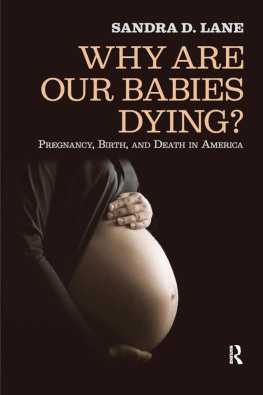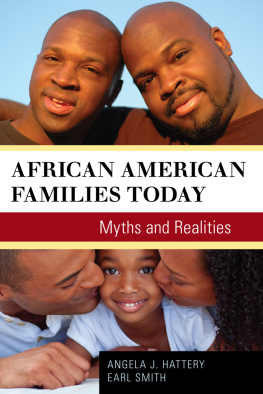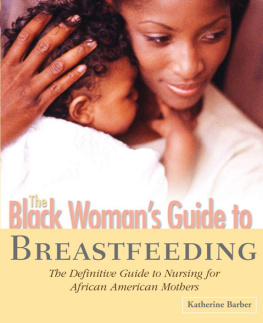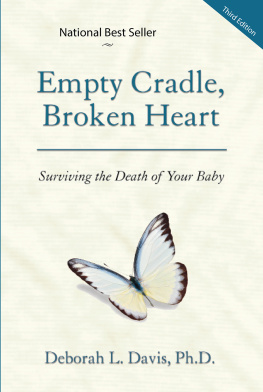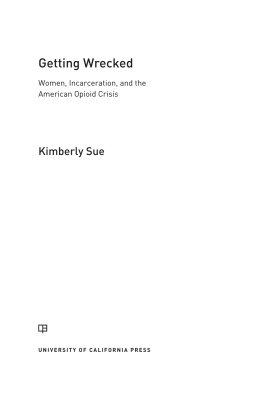WHY ARE OUR BABIES DYING?
WHY ARE OUR BABIES DYING?
PREGNANCY, BIRTH, AND DEATH IN AMERICA
Sandra D. Lane
First published 2008 by Paradigm
Publishers Published 2016 by Routledge
2 Park Square, Milton Park, Abingdon, Oxon OX14 4RN
711 Third Avenue, New York, NY 10017, USA
Routledge is an imprint of the Taylor & Francis Group, an informa business
Copyright aoo8, Taylor & Francis.
All rights reserved. No part of this book may be reprinted or reproduced or utilised in any form or by any electronic, mechanical, or other means, now known or hereafter invented, including photocopying and recording, or in any information storage or retrieval system, without permission in writing from the publishers.
Notice:
Product or corporate names may be trademarks or registered trademarks, and are used only for identification and explanation without intent to infringe.
Library of Congress Cataloging-in-Publication Data
Lane, Sandra D.
Why are our babies dying? : pregnancy, birth, and death in America / Sandra D. Lane.
p. cm.
Includes bibliographical references and index.
ISBN-13: 978-1-59451-440-1 (hardcover)
1. InfantsMortalityUnited States. 2. Social problemsUnited States. I. Title.
HB1323.I42U644 2008
304.640973dc22
2007045743
ISBN 13 : 978-1-59451-440-1 (hbk)
ISBN 13 : 978-1-59451-441-8 (pbk)
Designed and Typeset in New Baskerville by Straight Creek Bookmakers.
To Robert
To Helen
and in the memory of my parents, Mae and Fred Lane
Contents
Shortly after arriving in Syracuse in 1996, I learned that the infant mortality rate in Onondaga County was historically one of the highest in the United States. Moreover, the infant mortality rate for people of color in the county was so high that the rate approximated what might be found in a developing country. Two months later, I was hired by the county health department with the charge to write grants to support infant mortality reduction. My contract for this employment was run through Syracuse Model Neighborhood Facility, Inc. (SMNF), a comprehensive community agency operated by and serving the Syracuse communities of color. In the now eleven years since, I have worked closely with and benefited greatly from the friendship of the SMNF staff. My enormous respect for their work led me to allocate my authors royalties for this book to the SMNF.
When I began to fulfill the health department assignment of writing grants to reduce infant mortality, I approached the task as would any anthropologist arriving in a new place. I went into the field. I met with community groups, nonprofit agency staff, and county employees. I led a team that wrote a successfully-funded federal Healthy Start grant and became the founding director of Syracuse Healthy Start, a project that still provides needed services to prevent infant death. After five years I left Syracuse Healthy Start to join the Department of Obstetrics and Gynecology at SUNY Upstate Medical University. I wanted to study in greater depth the intersection of imbedded racism, discrimination, poverty, and premature mortality in Syracuse. I am now part of a research team of some twenty faculty, students, and community members that not only searches for risk factors and potential solutions to health inequalities, but also communicates our findings to community members, elected officials, and policymakers. In 2005, I became chair of the Department of Health and Wellness, in the College of Human Services and Health Professions at Syracuse University, where I have found numerous colleagues who also bridge analysis and activism on the gap in health and survival.
My perspective in this work comes from my doctorate in medical anthropology and masters degree in epidemiology, as well as more than a decade of work as a registered nurse in the beginning of my career. I also lived and worked in Egypt for five years, where I developed expertise on maternal and child health in developing countries, first as a doctoral student, then as a Ford Foundation program officer. In my Syracuse research I have been struck by how similar the problems are in the developing and developed worlds. Inadequate education and low literacybarriers to healthcare posed by poverty, discrimination, and misguided policies made on the basis of short-term fiscal analysiswreak havoc in both settings.
A second major finding of our work led me to question the individual responsibility model that guides a wealth of public health interventions. We found that, considering such health risks as the use of illicit drugs or alcohol, pregnant white women were quite similar to pregnant women of color in Syracuse. Pregnant white women, moreover, smoke cigarettes at higher rates than women of color. Findings like these forced us to go beyond individual-level risks to look at disease-inducing environments. In several cases described in this book, we found that such environmental risks as lead poisoning, lack of supermarkets, and disproportionate incarceration seem to account for much of the health inequality of African Americans and Latinos. Our findings do not indicate that individual-level risks should be ignored. Indeed, we should all try to avoid smoking, eat healthful food, and wear our seatbelts. But individual-level risks do not fully explain the racial/ethnic health gap.
With numerous co-authors I have published eleven articles based on our analysis of health disparities in Syracuse. I wrote this book to bring together and describe in one volume a decade of work on unequal health and survival for babies (and people throughout the life span), caused by poverty and structural discrimination. I have tried to write as simply and clearly as possible, not an easy task for an anthropologist at the turn of the second millennium, in which our profession increasingly values impenetrable prose. I hope this book will be useful to community members in their efforts to improve the conditions in which they live. I have also written the book for students of anthropology and other social sciences, medicine and other health professions, and bioethics.
Sandra D. Lane
Syracuse, New York
August 2007
U NTIL NOW I HAVE FULFILLED the publish or perish academic mandate by producing articles, which I co-author with university colleagues, students, and community collaborators. Most of my research team members become friends with whom I work on project after project. Some of my students have become like family members; I have attended their graduations, weddings, and sometimes even the births of their children. Many of our grant proposals and study designs have been drafted around my kitchen table over food and wine. I wanted to write this book to tell the story of our work on infant mortality in Syracuse and to integrate into one volume the results of the studies and programs that we have accomplished together. This work is theirs as well as mine.
I hold appointments in two universities: Syracuse University and Upstate Medical University. At Syracuse University I want to thank Chancellor Nancy Cantor, whose commitment to university-community linkages, social justice, and support for our efforts is invaluable. The dean of the College of Human Services and Health Professions, Diane Lyden Murphy, is another leader for social justice and I am very grateful for her support. Rob Keefe, Michael Freedman, Don Mitchell, Jonnell Allen, Ambika Krishnakumar, Jo Thomas, Kim Jaffee, Carrie Smith, Deborah Monahan, Arthur Paris, Vennie Cowart, Kelly Pettingill, Lisa Mignacca, and Eric Kingson have all contributed their efforts to improve community health in Syracuse. At Upstate, I want to thank my chair, Shawky Badawy, for his mentoring and encouragement. Department of Obstetrics and Gynecology colleagues Richard Aubry, Martha Wojtowycz, Linda Newell, Phillip Ferro, Rob Silverman, John Folk, John Nosovitch, Maria Czerwinski, Pam Parker, Mary Marone, Mary Ellen Hane, Anne Marie Seller, and Elizabeth Chapman have worked tirelessly to provide the highest quality obstetrical and reproductive care to the Syracuse community. Jerrold Abraham, Gerry Hall, Theresa Hargrave, Judy Crawford, Paula Rosenbaum, and Chien-Chih Liu, my colleagues on the asthma triggers study, are incredibly dedicated. Other health care providers, Steve Blatt, Anne Barrash, Anne Botash, Larry Consenstein, Celeste Madden, Cathy Patrick, Joan Vincent, Daphene Johnson, Tanya Paul, George Stanley, Marge Ostrander, Rhonda Sussman, Janet Press, and Gerry Galaresee devote time and attention, well beyond their official duties, to reduce infant mortality in Syracuse.

